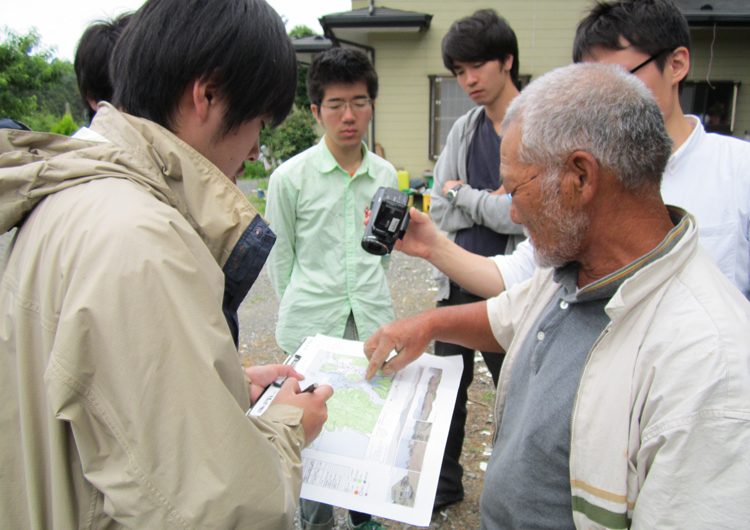
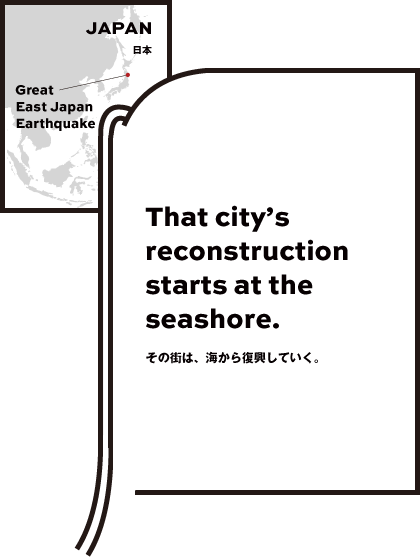 That city’s reconstruction starts at the seashore.
That city’s reconstruction starts at the seashore.
-


- 復興期
- 建築
- General Incorporated Association ArchiAid
- Oshika Peninsula Support Activities
Connect those who want to support with those who need support on a national scale
One of the most important characteristics of ArchiAid is that it functions as a platform for post-disaster assistance, bringing together architects and students from across the country seeking to extend their help to disaster areas and to address the needs of disaster-stricken areas wanting to have support from building experts. It was during the summer camp dubbed, “Go out into the Peninsula” held in August 2011 that ArchiAid played that particular role for the first time. Architects and 111 students from 15 universities gathered from many parts of the country to support the Oshika Peninsula, Ishinomaki City, Miyagi Prefecture.
Before the camp, ArchiAid members led by Shoko Fukuya of Tohoku Institute of Technology visited 30 coastal communities of various sizes in the Oshika Peninsula and met their leaders to seek their understanding about ArchiAid’s activities. After these preparations, each participating university visited the coastal communities and, through fieldwork and interviews, developed a trust-based relationship with residents. The same type of summer camp was held in 2012 as well. Without ArchiAid acting as an intermediary between residents and administrative agencies in these coastal communities, it would have been difficult to conduct such extensive support activities.
According to Director-General of ArchiAid, Masashige Motoe, what led him and his colleagues to set up ArchiAid at an early stage of the post-disaster reconstruction process was a close cooperative network of professor architects that had existed since before the disaster and their regret about the fact that architects could not make good use of their professional skills in the reconstruction process after the Great Hanshin-Awaji Earthquake. ArchiAid, therefore, is a product of bitter lessons learned from that devastating earthquake of 1995. Even today, professors and students from the participating universities gather in Tokyo once a month to have a Peninsula Support Study Meeting, during which they share the reconstruction status of each costal community, discuss challenges, exchange information concerning the reconstruction process of the entire Oshika Peninsula, thereby continuing their commitment to support for the coastal areas.
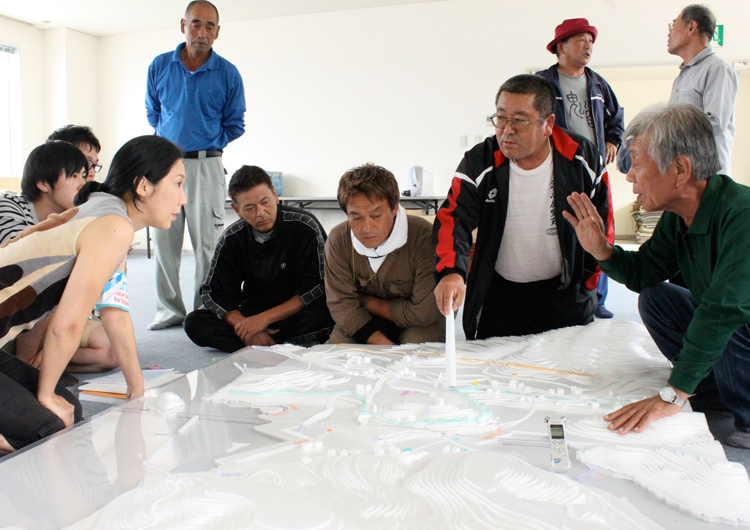
- Fukuya (left) talking with people in the coastal area
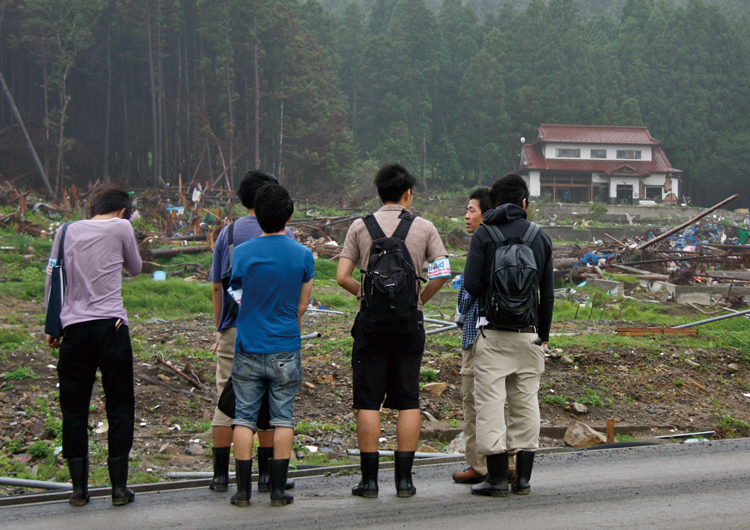
- Students setting out for fieldwork
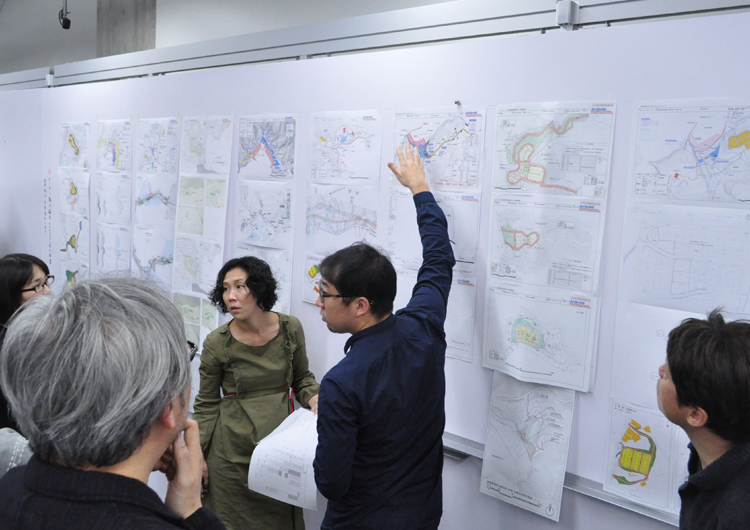
- “Peninsula Support Study Meeting” held once a month
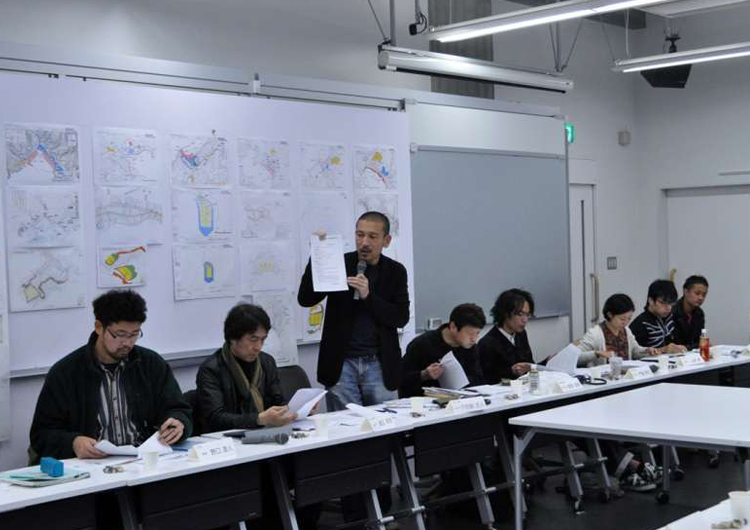
- Continuing support activities by exchanging information
It's not where you live; it's how you live
In the Group Relocation for Disaster Mitigation project, Japan’s Ministry of Land, Infrastructure, Transport, and Tourism conducts surveys to “promote the relocation of housing to higher grounds.” Meanwhile, surveys conducted by ArchiAid as part of the Oshika Peninsula Support Activities have consistently aimed to collect first-hand opinions from the residents as to what kind of lifestyle they wish to have after moving to higher ground and how they want to use their properties in lower altitudes, thereby reflecting such opinions in the reconstruction plans. Students played major roles in these surveys. “Rather than trying to teach residents what is the right thing to do, these students were willing to learn from the residents and their humble attitude brought out candid opinions from the residents,” says Fukuya. There were subjects that the residents hesitated to talk about with officials, but with the students, who were of the same generation as their own children and grandchildren, the residents found it easier to discuss them.
The students carefully listened to what the residents had to say about their communities’ characteristics before the disaster, their lifestyles, buildings, landscapes, etc. and put them together in a booklet, A Pattern Book for Oshika Peninsula- Envisioning the Future of the Coastal Communities Based on the Coastal Lifestyle. Without grasping the present and past situations of the communities, it is impossible to envision their future. These fine-tuned support activities tailored to the needs of the coastal communities were made possible by the participation of the students who listened to the residents’ voices and ensured their views were incorporated into the reconstruction plans.
Support building a town, going beyond the boundaries of “architecture"
In August 2013, a training session called the “Oshika Fisherman’s School” was held in the Momonoura district in the Oshika Peninsula. The event was hosted by the Executive Committee for Momonoura Coastal Community Development and co-hosted by Ishinomaki City, University of Tsukuba, and ArchiAid. From inside and outside Miyagi Prefecture, 15 people, which happened to coincide with the enrollment limit, applied for participation in the event aimed at helping develop fishermen, human resources that play a central role in the history and culture of the coastal community. This three-day intensive program comprised lectures and practical training that also included sailing in a fishing boat.
The idea of the Oshika Fisherman’s School had been proposed by some residents after the 2011 summer camp. All the coastal communities in the Oshika Peninsula had long faced such common problems as the aging of fishermen and shortage of successors, which eventually would lead to the decline of the fishing industry. The earthquake and tsunami revealed these challenges all at once. Born and brought up in Momonoura and having sailed a ship himself as a fisherman, Tsuyoshi Koya says, “Even if we have a nice port built in the reconstruction project, it would not lead to the revival of the coastal communities if we have no people left to use it. The earthquake and tsunami linked us to the members of the Kaijima Lab of the University of Tsukuba. Without their help, we could not have organized this kind of training program. Working with our supporters, we would like to revive our fishing community so that it can be a model case for other coastal communities”.
The Kaijima Lab’s wish to support rural communities by solving various problems in cooperation with their residents, including problems that have long beset depopulated communities, led to the launch of the Oshika Fisherman’s School at the initiative of the residents of Momonoura.
The issue is not only how to design individual houses and landscapes, but also how to rebuild the future of the coastal communities as a whole. We should consider what kind of long-term support should be provided to effectively address the needs of residents. Addressing these issues will be a critical test for the future development of ArchiAid activities.
